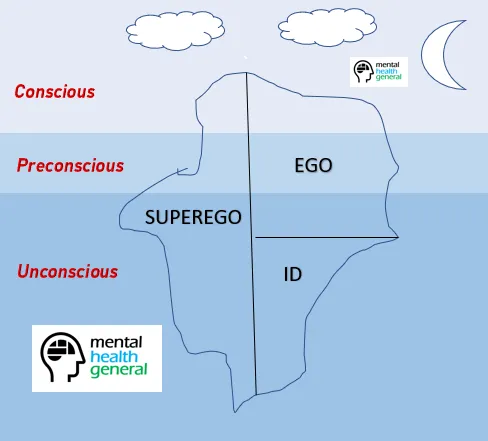The Superego forms a key part of Sigmund Freud’s theory of personality. He reasoned that it is one of three areas, alongside the “ego” and the “id”, which make up a person’s personality.
But if we drill deeper into Freud’s theory, the superego can itself be expanded upon, with two distinct areas within it, as we explore in this article. This forms an important part of Freud’s overall theory.

Freud’s Theory of Personality
Freud’s theory of personality is based on the idea that there are three components of personality – the Id, the Ego, and the Superego [1]. Freud likened personality to an iceberg; an individual can only see a small piece of personality (i.e. the tip of the iceberg above the water), with most hidden away from view (like the iceberg).
The tip of the iceberg refers to what a person is aware of, and the forefront of the mind – as they are aware, it is considered to be the “conscious mind”. But under the water, there is an “unconscious mind” – where hidden thoughts, memories, feelings and desires are present [1].
The id is within the unconscious mind, and is the part of the personality that controls an individual’s urges, needs and desires – with it aiming for pleasure. The id of the person will want to reach these pleasurable outcomes as quickly as possible.
The ego, Freud suggests, has the task of organising our thoughts to make our mind learn in a coherent way. It can help with any problems the id is facing, such as whether or not it should behave in a certain way. It can help the person to make sensible decisions.
The superego
The third key area in Freud’s theory is the superego. It can be seen as the part of our personality that essentially makes each person’s ideas of right and wrong. To achieve this, societal and cultural norms will usually help form a person’s senses of right and wrong, along with parental behaviour and other factors.
The superego can be seen as a person’s conscience. The superego helps us top judge the desires of the id – to the extent that Freud argued it is the “parent in our head”.
There are two parts within the superego: the ego ideal, and the conscience. These two areas are explored in more detail below.
The ego ideal of the superego
This part of the superego is essentially attempting to make us become the person we want to be in relation to what is right and wrong – the ‘ideal’ person.
It can set rules for us with the intention of resulting in good behaviour from ourselves. This should result in a person being approved of by those close to us and society as a whole.
It is also important to note that if a person’s standards or ideals are too high, it can result in a person becoming guilty or feeling like a failure.
The conscience of the superego
Meanwhile this part of the superego includes certain information about actions and behaviours that are viewed as ‘bad’ by society.
A person will aim to avoid these behaviours – as a person will typically come into harm when engaging in such behaviours.
When doing so, a person will feel guilty – and will have gone against their conscience. Some people may view it as an “inner voice”.
The conscience is able to punish the ego by causing it feelings of guilt. This may arise if the ego gives in to the id – and therefore just acts in a way to meet their needs without thinking about the consequences.
What this means
Taking these areas into account, the superego will then attempt to ensure a person’s behaviour is as perfect as possible. It will aim to provide a strong argument to counteract the id’s impulsive nature, leading to the ego making a decision.
In most cases, a person’s superego will overwhelm the id, though this isn’t always the case. When the id overwhelms the superego, then harmful behaviour will normally befall the person.
Summary
Overall, Freud’s theory suggests that the superego plays an important role in a person’s personality and overall actions. It is a crucial part of a person acting in a morally and socially appropriate way.
While Freud’s theories aren’t universally accepted, they do form an important foundation of knowledge that some modern-day therapies are based around – such as Psychoanalytical Psychotherapy and Psychodynamic Psychotherapy.
See Also
- Overview of Sigmund Freud and His Theories
- Freud’s Theory of the Id, the Ego and the Superego
- Freud’s Theory of the Id and Mental Health
- Freud’s Theory of the Ego and Mental Health
- Freud’s Theory of the Superego and Mental Health
- Explaining The Two Parts of the Superego According to Freud
Disclaimer
This website should be used purely for informational purposes, and does not intend to, nor should it ever, be used as a replacement for professional medical advice.
We strive to keep all of our pages updated, and ensure that our website is full of factual and in-depth information. However, we encourage you to browse this website with care.
As a reminder, this website and all content within it cannot and should not replace the advice of a trained medical professional. You can read our full disclaimer at this link.
Helplines
If you are struggling with your mental health, help is available. With the right support and treatment, you can make a recovery. For information on helplines, or if you are in a state of crisis, please visit our crisis page by clicking on the relevant link for your geographical location (United Kingdom), (United States), (International). You can also see how to get mental health treatment and the process involved by clicking this link.
References
[1] Freud, S., & Hall, G. S. (1920). A general introduction to psychoanalysis. Boni and Liveright: New York.



































